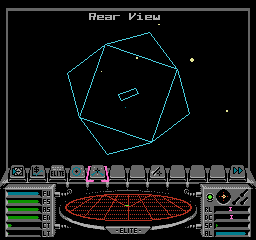Information on the "impossible" version of Elite

The NES version of Elite is legendary. This quote from co-author Ian Bell says it all, really:
My greatest published achievements technically would have to be fitting BBC cassette Elite into 32K of RAM including the screen, and later the Nintendo Entertainment System conversion of Elite that used a character-mapped display and a single NES controller. The NES is my favourite published conversion and was not thought technically feasible until we'd done it.
There is no doubt that NES Elite is an epic technical achievement, and even today there is much speculation about how the authors managed to coax vector graphics out of the console's tile-based bitmap display (though hopefully this site finally answers all those questions).
Looking beyond the impressive fact that the game even exists, the NES version feels like a fitting culmination of the 8-bit era of Elite. This is partly down to the fact that it incorporates features from across the entire range of 6502 versions; it's almost like a "greatest hits" collection of 6502 Elite. The core of the game is the BBC Master version, which itself is a derivative of the BBC Micro disc version, but with added features from the Commodore 64 and Apple II versions such as fractional kills, different laser sights and the lightning effect. Then there's the music and the Trumbles mission from the Commodore 64 version, the scroll text demo from the 6502 Second Processor version, and an auto-play system that harks back to the Elite Demo that was released to dealers back in 1984. It's quite the grab-bag.
That said, NES Elite is a challenge to play. On the BBC Micro the game is so complex that the original version came with its own fold-out guide to the game's many controls, but the NES controller only has eight buttons in total, far fewer than even the most basic console controller today. The solution is the game's icon bar, which very elegantly addresses the problem, but it does have its limitations (it is not possible to steer and change speed at the same time, for example). NES Elite is therefore a bit of a shock for the keyboard warriors among us, though the authors did try to help by making the game slightly easier in a number of subtle ways. The most obvious of these is that you can use a docking computer without actually owning one, so new players no longer have to learn how to dock manually; the only downside is that the station charges you a five-credit fee for their auto-dock service, though this is waived if you've got your own docking computer fitted.
Luckily the NES version oozes charm, from the colourful system and commander images, to the multi-language support for English, German and French. It's easy to see why Ian Bell is so fond of it, and its beating heart is literally the original Acornsoft Elite, so what's not to like?
Here are some suggestions for exploring this version of Elite:
- Navigate the codebase using the map of the source code, A-Z index and source code cross-references.
- Find out how this version works under the hood with over 130 deep dive articles covering every aspect of the game.
- Play NES Elite in your browser.
- Download a ROM image of this version from the downloads page, which you can load into an emulator or real machine.
- See the code statistics for this version.
- See exactly how this version compares to the others in the feature comparison table.
- See comprehensive details of all the different variants of this version.
- Download the game from Ian Bell's site as a ROM image with instructions.
- Build this version from the source code with the accompanying GitHub repository.
- Visit Frontier Astro to see the box contents for this version of Elite.